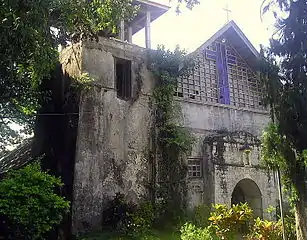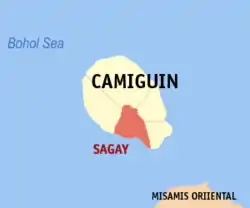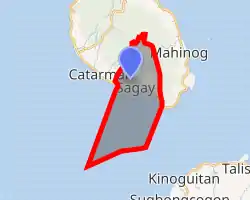Sagay, Camiguin
Sagay, officially the Municipality of Sagay, is a 5th class municipality in the province of Camiguin, Philippines. According to the 2015 census, it has a population of 12,626 people. [3]
Sagay | |
|---|---|
| Municipality of Sagay | |
 Sagay Church | |
 Map of Camiguin with Sagay highlighted | |
OpenStreetMap 
| |
.svg.png.webp) Sagay Location within the Philippines | |
| Coordinates: 9°07′N 124°43′E | |
| Country | |
| Region | Northern Mindanao (Region X) |
| Province | Camiguin |
| District | Lone District |
| Founded | July 31, 1909 |
| Barangays | 9 (see Barangays) |
| Government | |
| • Type | Sangguniang Bayan |
| • Mayor | Joseph G. Uayan |
| • Vice Mayor | Nestor E. Tongol |
| • Representative | Xavier Jesus D. Romualdo |
| • Electorate | 9,386 voters (2019) |
| Area | |
| • Total | 44.13 km2 (17.04 sq mi) |
| Elevation | 116 m (381 ft) |
| Population | |
| • Total | 12,626 |
| • Density | 290/km2 (740/sq mi) |
| • Households | 2,875 |
| Economy | |
| • Income class | 5th municipal income class |
| • Poverty incidence | 44.93% (2015)[4] |
| • Revenue | ₱48,764,430.73 (2016) |
| Time zone | UTC+8 (PST) |
| ZIP code | 9103 |
| PSGC | |
| IDD : area code | +63 (0)88 |
| Climate type | tropical rainforest climate |
| Native languages | Kinamigin language Cebuano Tagalog |
| Website | www |
History
The town square of Sagay includes a British cannon. This cannon has been dated at 1707, and is a nine-pounder Demi-Culverin. It can clearly be identified as British by the emblem on the top which includes the Tudor rose. It was possibly left behind in 1763 after the siege of Manila, and perhaps was brought to Camiguin by the Spanish to defend against Moro raiders.
In 1909, the municipality of Sagay was created. Prior to this date, Sagay town had been a part of the municipality of Catarman. Initially, Sagay municipality included the town of Guinsiliban, but that later became a municipality in its own right.
In 1942, the Japanese Occupation forces entered the town of Sagay, Camiguin.
In 1945, the town of Sagay was liberated by the invasion of the Filipino forces of the 6th and 10th Infantry Division of the Philippine Commonwealth Army who attacked the Japanese Imperial forces during the Battle of Camiguin at the end of World War II.
Barangays
Sagay is politically subdivided into 9 barangays.
- Alangilan
- Bacnit
- Balite
- Bonbon
- Bugang
- Cuña
- Manuyog
- Mayana
- Poblacion
Climate
| Climate data for Sagay, Camiguin | |||||||||||||
|---|---|---|---|---|---|---|---|---|---|---|---|---|---|
| Month | Jan | Feb | Mar | Apr | May | Jun | Jul | Aug | Sep | Oct | Nov | Dec | Year |
| Average high °C (°F) | 28 (82) |
29 (84) |
30 (86) |
31 (88) |
30 (86) |
30 (86) |
30 (86) |
30 (86) |
30 (86) |
30 (86) |
29 (84) |
29 (84) |
30 (85) |
| Average low °C (°F) | 24 (75) |
24 (75) |
24 (75) |
25 (77) |
26 (79) |
26 (79) |
25 (77) |
25 (77) |
25 (77) |
25 (77) |
25 (77) |
25 (77) |
25 (77) |
| Average precipitation mm (inches) | 271 (10.7) |
217 (8.5) |
193 (7.6) |
178 (7.0) |
344 (13.5) |
423 (16.7) |
362 (14.3) |
358 (14.1) |
329 (13.0) |
320 (12.6) |
322 (12.7) |
260 (10.2) |
3,577 (140.9) |
| Average rainy days | 23.2 | 19.5 | 22.0 | 22.8 | 29.6 | 28.9 | 30.3 | 29.8 | 28.1 | 28.8 | 26.1 | 24.1 | 313.2 |
| Source: Meteoblue [5] | |||||||||||||
Demographics
| Year | Pop. | ±% p.a. |
|---|---|---|
| 1903 | 6,321 | — |
| 1918 | 8,551 | +2.03% |
| 1939 | 9,907 | +0.70% |
| 1948 | 18,061 | +6.90% |
| 1960 | 7,552 | −7.01% |
| 1970 | 8,559 | +1.26% |
| 1975 | 7,728 | −2.03% |
| 1980 | 9,120 | +3.37% |
| 1990 | 9,494 | +0.40% |
| 1995 | 9,243 | −0.50% |
| 2000 | 10,356 | +2.47% |
| 2007 | 11,198 | +1.08% |
| 2010 | 11,873 | +2.15% |
| 2015 | 12,626 | +1.18% |
| Source: Philippine Statistics Authority [3] [6] [7][8] | ||
In the 2015 census, the population of Sagay, Camiguin, was 12,626 people, [3] with a density of 290 inhabitants per square kilometre or 750 inhabitants per square mile.
References
- Municipality of Sagay | (DILG)
- "Province: Camiguin". PSGC Interactive. Quezon City, Philippines: Philippine Statistics Authority. Retrieved 12 November 2016.
- Census of Population (2015). "Region X (Northern Mindanao)". Total Population by Province, City, Municipality and Barangay. PSA. Retrieved 20 June 2016.
- "PSA releases the 2015 Municipal and City Level Poverty Estimates". Quezon City, Philippines. Retrieved 12 October 2019.
- "Sagay: Average Temperatures and Rainfall". Meteoblue. Retrieved 4 March 2020.
- Census of Population and Housing (2010). "Region X (Northern Mindanao)". Total Population by Province, City, Municipality and Barangay. NSO. Retrieved 29 June 2016.
- Censuses of Population (1903–2007). "Region X (Northern Mindanao)". Table 1. Population Enumerated in Various Censuses by Province/Highly Urbanized City: 1903 to 2007. NSO.
- "Province of Camiguin". Municipality Population Data. Local Water Utilities Administration Research Division. Retrieved 17 December 2016.
External links
| Wikimedia Commons has media related to Sagay, Camiguin. |